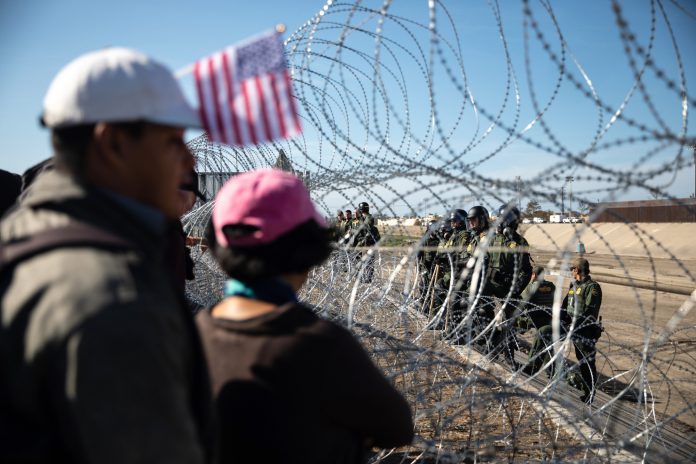
The Department of Homeland Security announced new measures Thursday to require asylum seekers who enter the United States illegally to return to Mexico and wait while their claims are processed, possibly for months or years, describing the plan as one of the most significant changes to immigration policy in decades.
Homeland Security Secretary Kirstjen Nielsen outlined the plan during an oversight hearing with members of the House Judiciary committee, telling lawmakers the administration is preparing to implement the measures in coming days. Mexico’s new leftist government separately announced Thursday it will allow the United States to send asylum seekers who cross illegally back to its territory and provide them with work visas and humanitarian assistance while they wait.
The policy is likely to face legal challenges, and federal courts have repeatedly blocked the Trump administration’s efforts to tighten border controls by executive action. Nonetheless, the deal amounts to a significant diplomatic win for the administration, which has engaged in sensitive talks for months to cajole Mexico to become an immigration antechamber for U.S. asylum seekers from Central America.
Citing emergency powers allowed under the Immigration and Nationality Act, Nielsen said the measures were needed to “bring under control” a surge of unmerited asylum claims by Central Americans that have overloaded U.S. immigration courts.
“Once implemented, individuals arriving in or entering the United States from Mexico – illegally or without proper documentation – may be returned to Mexico for the duration of their immigration proceedings,” she said.
“They will not be able to disappear into the United States. They will have to wait for approval to come into the United States. If they are granted asylum by a U.S. judge, they will be welcomed into America. If they are not, they will be removed to their home countries,” Nielsen said.
The United States has been in negotiations with Mexico for weeks to reach such an accord, which had been referred to as “Remain in Mexico,” believing that illegal crossings will decline if Central Americans believe the asylum system will no longer offer them a way to avoid deportation.
Top officials from the government of Mexican president Andrés Manuel López Obrador have said they would accept such measures as part of a broader development and aid package aimed at creating jobs in Central America to reduce the need to emigrate.
In a statement, Mexico’s foreign ministry said Thursday it “will authorize, for humanitarian reasons and temporarily, the entry of certain foreign persons from the United States who have entered the country through a port of entry or who have been apprehended between ports of entry, have been interviewed by the authorities of migratory control of that country, and have received a summons to appear before an immigration judge.”
They will be allowed “to our country so that they can wait here for the development of their immigration process in the United States,” the statement read.
“They will be entitled to equal treatment without any discrimination and with due respect to their human rights, as well as the opportunity to apply for a work permit so they can find paid jobs, which will allow them to meet their basic needs,” it continued.
It’s not immediately clear how Mexico will pay to provide humanitarian support for tens of thousands of asylum seekers. Mexico has slashed its budget for refugees in recent years, and López Obrador’s proposed budget for next year includes a 20 percent funding cut for its refugee agency. The new president has long spoken about the need to respect migrant rights, but many in Mexico saw his budget announcement as a sign of his priorities.
In recent weeks, following the arrival of a large migrant caravan in Tijuana, Mexico’s lack of preparedness has become clear. When the caravan arrived, the government initially created a makeshift shelter in a sports complex. It was cramped, flood-prone and presented public health risks.
Last weekend, two Honduran teenagers who were part of the caravan were found murdered in Tijuana. Mexican police said the two boys had left a shelter for migrant youths and were killed in an apparent robbery attempt. It’s unclear whether the boys had applied for asylum in the United States.
Other parts of northern Mexico present graver challenges for migrants. In the state of Tamaulipas, for instance, which borders southeastern Texas, migrants are regularly kidnapped and extorted, and there is limited space in shelters already inundated by deportees from the United States.
In Reynosa, kidnappings are so common that the city’s Casa del Migrante, run by a Catholic charity, has implemented a new rule: migrants are not allowed to leave. “They leave to buy a sandwich and they disappear,” said Sister Edith Garrido, who has worked at the shelter for three years.
Because asylum cases can drag on for months or years, it’s unclear how migrants would remain safe – with access to food and shelter – or how they would access legal services. It also remains unclear how Mexico will sell the deal to a domestic audience which has resisted the idea of embracing tens of thousands of Central American migrants.
On Tuesday, the Mexican government announced that the United States would contribute $10.6 billion to programs in southern Mexico and Central America that ostensibly would help curb migration. That announcement was perhaps an attempt assuage concern over the new asylum procedure.
But that funding mostly consists of money the United States already had allocated.
“I have to wonder if Mexico knows what it’s signing up for,” said Adam Isacson, a border security analyst at the Washington Office on Latin America (WOLA). “Wait times for asylum hearings are now routinely exceeding 1,200 days. That’s three years. Is Mexico really prepared to host hundreds of thousands of people for that long while they wait for overworked U.S. asylum judges to get to these people’s cases?”
(c) 2018, The Washington Post · Nick Miroff, Kevin Sieff
{Matzav.com}











